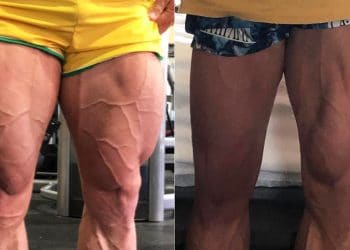Good muscle mass morning my friends, and welcome to a brand new week. I like the first day of the week more than most people I’m guessing, as I hear with some it’s not all that popular. Regardless of which side you’re on, it’s time to put the old week behind us and get on with some new and exciting challenges. I’m here to help steer your enthusiasm towards our favorite pastime, as the subject of training should put a smile on your face no matter what day it is.
This is the maiden voyage of what will likely be a new and improved look a muscle building, for the simple reason that there was a great many of you that really liked last weeks post How To Make Your Muscles Grow. I always will try my best to cater to what it is that you are most interested in, and from my observations, building muscle is one of those interests. It didn’t matter what article I posted, for seven days straight the post that got the most hits was How To Make Your Muscles Grow. Muscle is definitely making itself seen and heard at this corner of the internet.
This edition will feature one of the questions I get asked the most often – What is the best way to train to grow my muscles? That itself is a loaded question as there are many aspects of training to consider, which makes giving a simple answer not possible. That question will likely take several posts to get to the bottom of. This week we will begin by trying to figure out what the most effective method of training frequency is, and should be used to get the most growth from our muscles.
Let’s start with a trip back in time, to before there was anything resembling modern bodybuilding. Back then there was just lifting for strength, and the growth of the muscles just happened as a result. No one trained to get big muscles, they trained to get strong. Now the reverse is more likely to be true, with muscle growth being the primary goal, and strength a necessary step in the equation.
Muscle size and strength are not directly related. I’ve seen some Olympic lifters hoist ridiculously heavy weights with relatively little muscle by way of comparison, and I’ve seen some pretty big bodybuilders that don’t seem to be able to lift anywhere close to what it looks like they should be able to. While they are not directly related, it is safe to say that if you want to get bigger, you will also have to get stronger. The relation between the two may not be equal, but that is a truth nonetheless.
Getting back to these early pioneer bodybuilders, their training philosophy was to train the entire body three times per week. This followed a progression of a heavy training day, then a light day, then a medium day in reference to the volume of weight used. On the nutritional side of things the strategy was simple – eat more. So the plan was simply to get stronger and eat more and let the muscle adapt and grow. On paper, this is a pretty sound plan of attack.
Level Up Your Fitness: Join our 💪 strong community in Fitness Volt Newsletter. Get daily inspiration, expert-backed workouts, nutrition tips, the latest in strength sports, and the support you need to reach your goals. Subscribe for free!
The thinking behind the three times a week, whole body training strategy, was that it was believed that if the genes involved in muscle hypertrophy were kept active, then the muscles would grow faster. The increased frequency also lends itself to improved motor learning. This reminds me of how Olympic lifters train. They do their competition lifts every day. If you do something often you are going to get good at it. This is especially relative to strength as it is mostly a neural adaptation. The faster your adapt and become stronger, in theory, the faster the muscle will grow.
There were drawbacks to this approach, and this is why it is no longer used – at least not as part of a mass building program. A full body workout multiple times per week is a great way to get lean and muscular, but not a great way to put on mass after a certain point. At some point in time, the loads of will get too heavy to make training in this manner possible. I’m speaking of within the same training session, not necessarily training three times per week. This is because if you are starting off with squats for example, followed by deadlifts, bench presses and overhead presses, by the time you get to chin ups you’ll be exhausted and won’t have the energy needed to go to failure or likely anywhere even close to it.
Taking your muscles to the point of failure is necessary to stimulate new growth. If we were to attempt training in this manner, these training sessions would need to be very long in order to be effective. This time-consuming regimen becomes prohibitive as an effective training method for most, due to the fact that we can’t spend four hours in the gym training three days a week. Most of the time would be spent resting between exercises in an attempt to make performing at maximal intensity possible. Of course no amount of rest would compensate for a full body workout centered around heavy compound lifts.
On the opposite end of the training frequency spectrum, is the method of training each muscle group only once per week. I have done this method in the past and it seems to be a great way of maintaining muscle, but the time between sessions per muscle group is too long to accumulate appreciable growth. There is the advantage that you can perform many different exercises and pile on the reps as well, so it is a fun way to train in that regard. This method will likely only be effective with a very seasoned trainer and one that is using anabolics. I’m passing no judgement in that statement, I’m just saying that in order to maximize this method you are going to need to train each body part to the point of practically no return. At that point, enhanced recovery agents will be necessary.
If one were to try training in such a manner as a natural athlete, the results would not be very dramatic. The result of punishing a muscle to that extent is going to be increased demand put upon our recovery reserves. As a natural athlete only has a limited supply of these reserves, this type of training will not result in great gains due to the fact that the ability to recover is simply not there. This will obviously limit the growth of the muscle regardless of how hard the training is. This has been my experience with this type of training.
Level Up Your Fitness: Join our 💪 strong community in Fitness Volt Newsletter. Get daily inspiration, expert-backed workouts, nutrition tips, the latest in strength sports, and the support you need to reach your goals. Subscribe for free!
The happy medium of these two schools of thought is to meet in the middle. The standard number given to the amount of time our muscles need to completely recover is 72 hours. In my opinion, if it is maximal muscle growth that you are after, then this is probably on the low end of recovery time needed. This is depending on a few different factors of course. To look at those factors in more detail I would like to look at a few different methods of accomplishing what is a more married method of the two schools we have already discussed, using the 72 hour recovery period as a guide to frame the training strategies. The goal of this little observational and rational study will be to see if we can come up with which method will produce the most ideal results. Sound like a plan?
Getting back to that 72 hour recovery period guideline, that in my opinion I think may be on the shortish end of what is needed for maximal hypertrophy, there are many ways to make this work within this rule. For example if we are doing a three day a week training schedule, roughly broken down into upper body on Monday, lower body on Wednesday, and upper again of Friday with the weekends off, flipping the order the following week so that the body is hit completely three times in two weeks, there is plenty of recuperation time. There is enough that there really should never be any compromise regarding the ability to generate intensity due to the long periods between lifting. Add in a couple of days of sprints on the off days and you have a pretty good training regimen.
The downside to training like this is that on each training day there is an awful lot to do. It’s going to be tough putting your full intensity into training your chest, back and shoulders in the same session. Add your arms and core in and I have a lot of difficulty believing that anyone can do this effectively enough to stimulate any real tissue growth. The recuperation time is more than adequate, but of little real benefit. Remember we’re talking about maximizing muscle growth, because as far as a balanced training schedule for health I think this is a pretty good one, especially if time is a consideration.
Now to the opposite end again working within the confines of the 72 hour recovery window – lots of opposites today – is the three day body part split, six day a week schedule. This split is ideal for hitting the muscle groups hard due to the more broken up method of training them. It’s a lot easier to give your all when you just have chest and triceps to train on day one for example, than having to train the entire upper body. The ability to really focus on a much smaller target of muscles is a great for upping the training intensity.
There is of course the reality that those of us that train naturally aren’t going to be able to keep this up for long without beginning to overtrain. Going heavy and hard every three days, hitting the entire body twice a week is going to take its toll on our ability to recover. There is of course the option to do the first three days heavy, and the second three days as rep days, but that isn’t the ideal recipe for mass either. On a side note, I’ve done this method with moderate weights and worked in the eight to 15 rep range for a high volume of sets with short rest, and it works very well for getting cut. Especially if you add a moderate circuit element to it. For example bench, followed by rows, followed by dumbbell bench, followed by chin ups. Not ideal for mass, but great for conditioning.
So what are we supposed to do then? Every training method so far in regards to frequency has its drawbacks. Either not enough recovery time, or not enough time to focus our intensity to generate real tissue growth. We have learned so far that we need enough frequency to keep the gains continuous, but at the same time we need enough recuperation to keep the body growing. We need to not train too often, but often enough that when we do we can put the necessary focus and energy into each body part.
I would suggest, given everything that we have looked at, that training each body part every four to five days would be the ideal mix. An option to do this would be to use the three day split, but take the fourth day off, or to do a four day split and take the fifth day off. I would suggest that either of these two methods would provide the proper amount of recovery, while getting a good amount of frequency. Either of the two possibilities provides enough time to have a body part split that is not too cumbersome so as to allow for full concentration and intensity each and every training session.
An example of the ideal mass building program that I would personally endorse would go like this:
- Day 1. Chest, biceps
- Day 2. Back, hamstrings
- Day 3. Shoulders, triceps
- Day 4. Quads, calves
I would also add in some core training daily. This may not immediately contribute to mass, but it certainly will allow for it going forward. You can’t get stronger without an ever increasingly strengthened core.
As you can see, I paired chest and biceps. This is to maximize each muscles abilities. If it was chest and triceps, the triceps would be tired following the chest pressing movements. So triceps are paired with shoulders, which also are involved in a lot of pressing but the weights will be considerably lower when training shoulders. Back is paired with hamstrings for the reason that in my opinion, both are best trained with deadlifts and rows, and both of those exercises hit the same muscles. It’s unavoidable, so just train them as one. The quadriceps basically deserve their own day, but we need to take calf training equally seriously, so they are paired together. Ten minutes of core following each session and you’re good to go. You can add a little low-intensity cardio on the off day, but nothing that is going to eat into recovery abilities. Just enough treadmill or elliptical trainer to keep the metabolism humming along and flush the legs while we’re at it. Combine it with some light rowing, and a little skipping, and you will enhance full body recovery while keeping the body fat at bay.
That is what I would recommend if I were designing a mass building program. So this answers the portion of the question as to how I would break down the body part splits to maximize intensity and recovery. There are many specifics that I would like to get into regarding the specific exercises, reps and sets to accomplish mass training, and perhaps I’ll get into that next week depending on your response of course. If you would like me to go further with the approach I would take with sets, reps, exercises and other considerations for mass training, please let me know. I’m always trying to keep up with you and your training interests. It’s a big diverse world out there, and our microcosm of it, that being the gym, is no different. I’ll continue to be your tour guide to this world, and I appreciate you joining me every day. Let’s meet back here tomorrow, until then…
Happy Lifting!








